Sam Fisher is finally back with the release of Splinter Cell: Conviction Review on Xbox 360
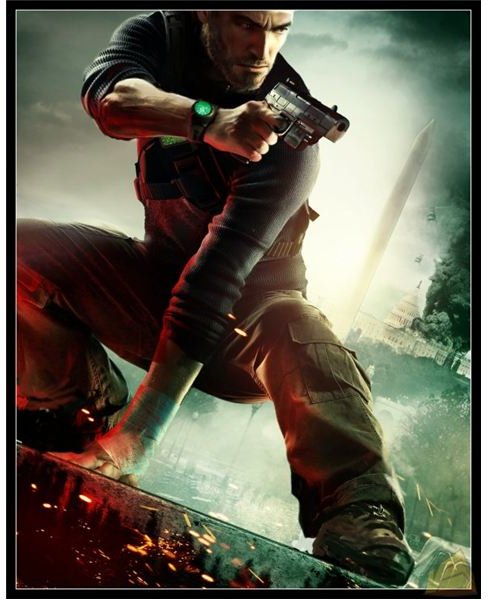
The return of Sam Fisher - Splinter Cell Conviction Review
Splinter Cell is one of the most refined franchises in gaming. Coming from the lucrative cash cow that is the Tom Clancy brand, it chooses to eschew the usual bang and bluster present in other Clancy titles (Ghost Recon, Rainbow Six), in favour of slow burn stealth mechanics and precise gameplay.
Taking the tactical espionage action perfected by the Metal Gear Solid franchise, Ubisoft utilised a painstaking attention to detail and quality that lasted for 3 games, until the formula became slightly stale in 2008’s Double Agent. A re-tool at that point was inevitable, but how would the developer bring Splinter Cell’s old school espionage into the next generation?
Story (5 out of 5)
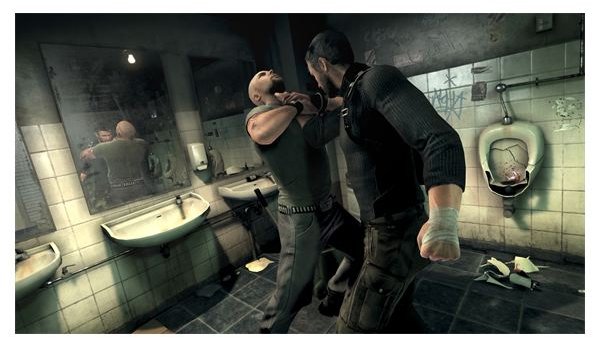
Taking place shortly after the events of Splinter Cell: Double Agent, Conviction sees Sam Fisher out for revenge against those responsible for his daughters death. Exiled from Third Echelon and without his friend Lambert (a sorely missed presence), Fisher is out in the cold, but far from vulnerable.
Sam Fisher has always been the best thing about the Tom Clancy games, amidst the one dimensional Ghosts and the stoic Rainbow 6 guys, Sam stands tall as a true gaming icon. Surviving on his predatory skills and quick wits, Fisher is a joy to control. Bourne without the memory loss, Bond without the misogyny, Fisher is a force of nature and he spends most of Splinter Cell: Conviction really pissed off. Resident storyteller Victor Koste informs us early on that Sam is not the man we once knew. Much like the game he inhabits, Sam Fisher is a changed man, the death of his daughter and best friend have turned him into a relentless killing machine bent on vengeance and nothing is going to stand in his way. Although, this being a Clancy game, all is not what it seems and Fisher soon finds himself involved with a shadowy PMC known as Black Arrow and trying to track down any information he can about his daughter. Splinter Cell: Conviction’s single player story is riveting while it lasts, Fisher is a brilliant protagonist and his magnetic presence keeps you hooked throughout.
Visuals (4 out of 5)
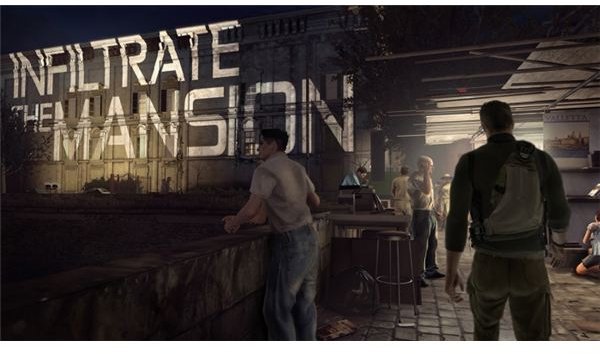
Splinter Cell: Conviction runs on the Unreal engine, which unfortunately means that, aesthetically, it looks like the majority of action games currently on the market. The smooth textures and earthy colour palette are instantly recognisable to anyone who has played Gears Of War or Bioshock. Fortunately, the Conviction developers have created some engaging environments to stalk around and the series’ trademark lighting and shadow effects are all present and correct.
The art style is, at times, wonderfully minimaliist. Objectives and context specific controls are projected onto the environment instead of flashing up on intrusive menu screens, this coupled with non existent loading times serve to immerse the player in a way not seen since the early Splinter Cell games. The new animation system is fluid and exhilarating, Fisher darts between cover, popping out to perform muscular takedowns. His speed and maneuverability is much more accessible than in previous games. Where previously Sam felt a little cumbersome as he slipped through the shadows, now he earns the ‘panther’ codename given to him by his pursuers.
The aforementioned lighting and shadow system needed to be perfect, this being a stealth game and all. Luckily Ubisoft and team Clancy don’t disappoint. As always in this series, light is a weapon and adapting to the environment is one of Sam’s key skills. The colour filter changes when Fisher enters the shadows, bathing everything in a eerie monochrome which, crucially, makes the player feel safe. It’s a panicky situation when your screen is suddenly filled with vivid colour.
Gameplay (4 out of 5)
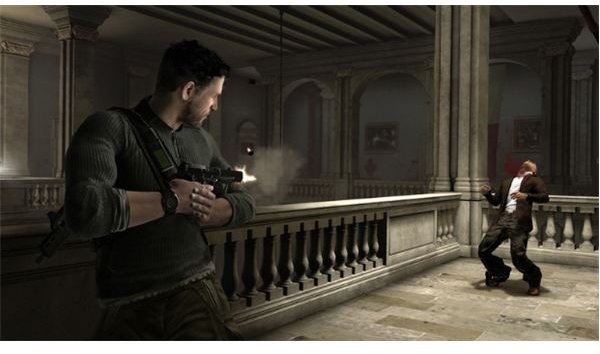
Here is where Splinter Cell: Conviction really comes into it’s own as a franchise re-boot. The control scheme and combat system have been completely overhauled, so much so that it is quite intimidating for a long time Splinter fan to enter into this game unprepared.
The main aspect of this new system is ‘mark and execute’, which allows players to tag a number (which increases as the player upgrades their weapons) of targets and have Sam quickly take them out before returning to the safety of shadow. It’s a wonderful mechanic that never stops rewarding, no longer will you be fumbling to get a bead on a target like in the previous games, in Conviction it’s a matter of pressing a button and watching the goons fall. You may think that this softens the difficulty of a franchise that prides itself on steep learning curves, but you’d be wrong. Mark and execute is a limited service and it’s usage is not infinite, Fisher must also rely on his usually array of gadgetry (sticky cam!) and some truly impressive close quarters combat to survive.
Another new gameplay mechanic worth mentioning is the ’last known position’, a quirky AI trick that has Sam leave a ghost-like silhouette when discovered. Quickly exit the immediate vicinity and you’ll find that the bad guys are fixed on that ghost, emptying bullets into nothing as you sneak up behind them to crack their skulls. This is another great feature that should become a franchise mainstay.
Co-Op (4 out of 5)
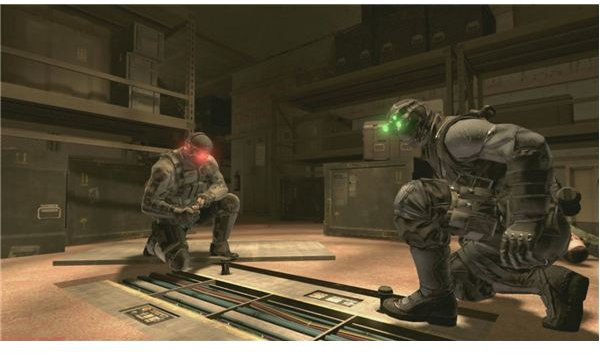
Splinter Cell: Conviction has a co-op mode that is far from tacked on. Unlike most games these days, SC:C doesn’t just present a few hours of mindless fun with a friend as a dessert to the single player campaign’s main meal, here the co-op mode accounts for about half the purchase price.
In the co-op campaign players take control of 2 third echelon spooks as they stalk their way through a generic terrorist plot that links tenuously to Sam Fishers single player story. Archer and Kestrel are basically old school Splinter Cells, they possess all the gadgets, equipment and svelte wardrobe that Fisher sported in his G-man days and as such represent a nostalgia tinged paean to fans, while at the same time working with Cnviction’s new skill set.
Whats impressive about the co-op campaign is how it feels complete, like a standalone title instead of an extra game mode. A lot of the skills needed for co-op are honed in the single player campaign so the two elements mesh perfectly. Overall Ubisoft have done a great job extending the life of this particular title long after the credits roll on Sam’s story.
Final Verdict
Splinter Cell needed to catch up after the tedious Double Agent, Ubisoft needed to go back to basics, strip everything down and leave nothing but Sam and stealth. Early teething problems resulted in a failed build of Conviction that was shown at E3 2008 to intrigued reviews. There is some evidence of that iteration on display here, crowd scenes and a ‘Fisher out in the cold’ storyline, but the evolution of Conviction is a shining example of re-invention done right.
There are some gripes. The mark and execute system is fussy at first and hard to contend with, it will alienate most players (I myself decried it when first getting to grips with Conviction) and perhaps draw some closer to its warm blanket style of play, before slapping them with one too many game over screens. The single player campaign is also far too short, which is probably a selfish observation given that there is so much content on the disc (including the excellent co-op mode) but Fisher’s brief stay is not satisfying enough after all his time away. And as for the brief sojourn to Fisher’s Gulf War days in which Splinter Cell goes all Modern Warfare on our asses, the less said about that the better.
All in all, Splinter Cell: Conviction is a great game. Best in the series? No, that honour still goes to the exemplary Chaos Theory. But Conviction does show that there is life in this once beaten franchise and Sam Fisher can break necks and shoot kneecaps long into this console generation.
